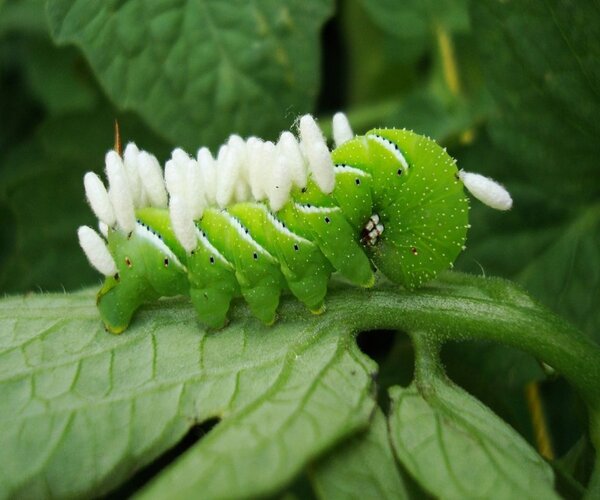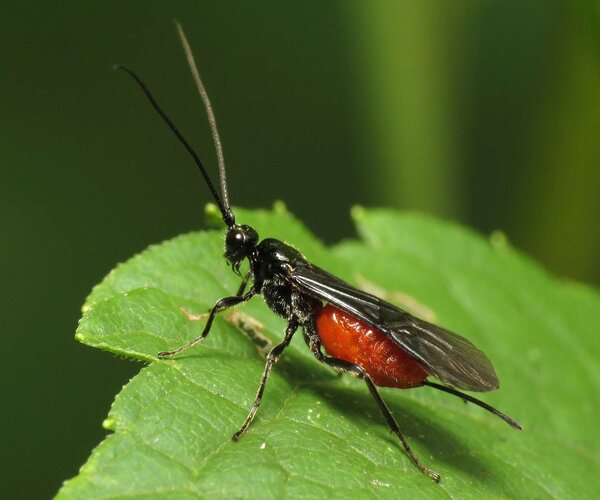What Are the White Eggs On Tomato Leaves? (Easy Explanation)
If you’ve ever noticed small white eggs on the leaves of your tomato plants, you may be wondering what they are and what you can do about them.
In this article, we will explain to you what exactly are these white eggs, what cause them and how to protect your tomatoes.
These eggs are a common sight in tomato gardens and are linked to a pest called tomato hornworm. Let’s see exactly how!
What Are Tomato Hornworms
Tomato hornworms are larvae of the five-spotted hawkmoth, a huge, heavy-bodied moth that is active at dusk. Green larvae with white diagonal stripes and a black horn or “tail” at the back of the body are characteristic.
They may grow to be 4 inches long and are known to inflict substantial harm on tomato plants and other nightshade family members such as peppers and eggplants.
Adult moths are huge and gray-brown in color, having wingspans of up to 4 inches. The five-spotted hawkmoth may be found over most of North America.
Adult moths deposit their eggs on the leaves of tomato plants and other nightshade plants, including tobacco, peppers, and eggplants.
The eggs hatch into small green larvae, having a lifespan of roughly 4-5 weeks. This is the length of their larval stage, following which they pupate and become adult hawkmoths.
Adult hawkmoths have a lifespan of around 2-3 weeks.
It should be noted that tomato hornworms are not poisonous. While they can cause damage to tomato plants, they are not harmful to humans. If ingested, they may cause stomach discomfort due to their tough exterior.
White Eggs On Tomato Leaves From Adult Hawkmoths
Adult hawkmoths lay their eggs on the leaves of plants, including tomato plants.
The eggs are small, white, and oval-shaped and can be found on the upper or lower surface of the leaves. They typically hatch within a week or so, and the emerging larvae (hornworms) will begin to feed on the tomato plant foliage.
These white eggs on tomato leaves are also primarily referred to as cocoons of wasp larvae. Cocoons of wasp larvae are protective structures that are created by the larvae of certain types of wasps, such as paper wasps and hornets.
Typically, these cocoons are formed of a substance produced by the larvae, like a silk or a combination of saliva and other substances. Inside the cocoon, the larva will metamorphose and finally emerge as an adult wasp.
Cocoons are typically seen in or near wasp nests and are used to shelter developing larvae from predators and other external hazards.
White Eggs Carried By Tomato Hornworms from Wasps

Tomato Hornworm is covered in all of these little things a lot of people think are eggs but they’re not these are actually tiny little cocoons of a wasp that parasitizes these guys by landing on them and laying their eggs inside of the hornworm.
The Tomato hornworms has been parasitized by an endoparasitic type (a parasite that lives in the internal organs or tissues of its host) ,that is, within its body, by what is likely the species of wasp (Cotesia congregata , Cotesia rubecula and Cotesia glomerata ),from a family of parasitic wasps known as braconids.
Tomato hornworms, do not lay eggs themselves. Parasitic wasps lay the white eggs you likely see on hornworms.
Wasps typically lay sixty-five eggs inside a hornworm and while they’re laying their eggs they also inject a poly DNA virus and what that does is it prevents the hornworms immune system from like ejecting the eggs.
Eggs of parasitic wasps are small, usually less than 1mm in length, and can be white, yellow, or brown in color. These eggs are oviposited (laid) by adult female parasitic wasps and are usually laid individually or in small groups.
Specifically, they use a stinger as a hypodermic needle to introduce the fertilized eggs of their young into the body of the hornworms caterpillars.
Once the eggs hatch, the wasp larvae will consume the hornworm and complete their development inside the host’s body.
The adult wasp will emerge from the host’s pupal case and continue the cycle. This common biological control method is considered a safe and effective way to control pests like tomato hornworms.
How Does Parasitoid Wasp Attacks The Hornworms

Wasp parasitism usually happens completely invisibly, and therefore it is difficult for gardeners to appreciate how useful it is to us. There is one exception, however: the hawkmoth braconid ( Cotesia congregata ).
The female wasp will locate the hornworm by detecting a pheromone that the hornworm releases. Once she finds a tomato hornworm, the female wasp will land on it and use her ovipositor to inject eggs into the hornworm’s body.
When the wasp eggs hatch, the wasp larvae begin to consume the hornworm, starting with non-vital tissues and eventually moving on to vital organs, eventually killing it.
The wasp larvae then spin cocoons on the hornworm’s body and later emerge as adult wasps.
This process can take several days to several weeks, depending on the species of wasp and the stage of development of the hornworm.
But what is utterly fascinating about this parasitism, is that these parasitoid wasps have coevolved with certain viruses that are injected along with the eggs inside of the host, a mutualistic symbiosis existing for tens of millions of years.
It’s important to note that while parasitoid wasps are effective at controlling hornworm populations, they should not be considered a solution on their own as they may need help to keep up with large infestations.
Additionally, different species of hornworm may not be affected by these wasps. Therefore, it’s essential to monitor your garden regularly and take action as soon as you notice any signs of a hornworm infestation.
How To Protect Tomato Leaves From Hornworms
There are a few ways to protect tomato leaves from Hornworms, which are standard methods used by gardeners to prevent insect damage on plants:
- Cover the plants: One way to prevent white eggs on tomato leaves is to cover the plants with a physical barrier, such as row covers or plastic sheeting. This will prevent insects from being able to lay eggs on the leaves.
- Keep the plants clean: Regularly inspecting and cleaning the plants can help to remove any white eggs on tomato leaves. This can be done by simply wiping the leaves with a damp cloth or using a water and dish soap solution.
- Use natural predators: Encouraging natural predators, such as ladybugs, lacewings, and parasitic wasps, can help to control the populations of pests that may lay white eggs on tomato leaves.
- Use insecticides: If the above methods are not effective, insecticides can be used to control pests that lay white eggs on tomato leaves. However, it’s important to use insecticides that are safe for edible plants and follow the instructions on the label carefully.
- Plant companion plants: Planting companion plants, such as marigolds, nasturtium, and borage, can help to repel or distract pests that can lead to the appearance of white eggs on tomato leaves.




